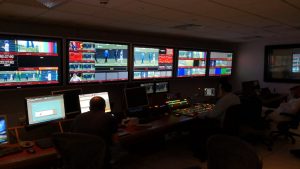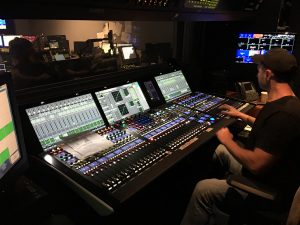NECF Completes Two Telecasts With Shared Marketplace Model
Story Highlights
NECF coordinated two live, distributed production telecasts for a major US regional sports network using a sharing marketplace consortium. NECF deployed its marketplace model on two football games in the Midwestern US, events that otherwise would not have been televised due to the expenses of either a traditional game broadcast or an at-home production.
 NECF’s distributed production system disrupts and leapfrogs the over decade-old, at-home/REMI concept and delivers annual cost savings for networks and television stations. Its sharing-economy collaborative of broadcasters and vendors offers new economies of scale, using patent-pending technologies and models to coordinate components of live video production from any location. By employing under-utilized production resources and staff, NECF provided an affordable and strategic solution. With capacity utilization of production assets estimated at less than 30% and an oncoming wave of vendor SaaS solutions, NECF’s logistics coordination and marketplace brings new business opportunities to distributors, vendors, manufacturers, and crews.
NECF’s distributed production system disrupts and leapfrogs the over decade-old, at-home/REMI concept and delivers annual cost savings for networks and television stations. Its sharing-economy collaborative of broadcasters and vendors offers new economies of scale, using patent-pending technologies and models to coordinate components of live video production from any location. By employing under-utilized production resources and staff, NECF provided an affordable and strategic solution. With capacity utilization of production assets estimated at less than 30% and an oncoming wave of vendor SaaS solutions, NECF’s logistics coordination and marketplace brings new business opportunities to distributors, vendors, manufacturers, and crews.
“It would not have been financially viable to produce these games through traditional methods,” says Joseph Maar, CEO, NECF. “We collaborated with the distributor, selected from a number of different production options, and jointly designed a system that maximized savings.”
For the two games, NECF coordinated a total of 24 marketplace partners, 15 in the US and nine in international locations. This provided the opportunity to eliminate the significant logistical costs associated with moving, housing and feeding production personnel on-site, as well as shipping the majority of production equipment to each venue or having a traditional and costly REMI control room. Only crew and equipment that was absolutely necessary at each venue or hub, needed to be located there.
NECF’s marketplace is a collaboration of broadcasters, media organizations, content creators, and vendors bringing the sharing economy into media production. The NECF marketplace matrixes from over 100 partners from various networks, vendors, manufacturers, and staff/talent providers. NECF also provides a platform for its marketplace partners to trial or showcase new video production technologies and processes to evaluate how they perform in the real world, while eliminating the risks associated live, on-air trials.
“As a consortium, we coordinate partners’ resources in a reliable manner that save broadcasters and media organizations time and money, while increasing their volume, margins, and productivity,” says Maar. “For content creators, we provide access to previously unaffordable technologies. For vendors, we leverage idle resources and their emerging SaaS technologies. And for production staff and crew, we provide an affordable way to work closer to home, sometimes even at home.”
Neither a vendor nor a technology company, NECF acts as an exchange desk for broadcasters and resource providers. Vendors including truck companies, communications firms, and talent/crew providers coordinate via NECF to directly service broadcasters.
For the two regional events, NECF architected resources so the network’s main production originated from a control room not originally designed to produce live sporting events. NECF coordinated and resourced the control room so it became capable of doing a seven-camera, live event with an equal number of replays. The events used announcers and reporter on-site, mic’d coaches, an RF camera, and even a drone. In addition to the main production, NECF ran “shadow” proof-of-concept productions originating from five additional locations. At each, crews produced alternative versions at differing price points or offered added production resources in a perfect-pairing, seamless sharing business model.
 “Clients are now able to remotely leverage our robust connectivity to utilize individual pieces of gear and our established infrastructure,” says Leland Herzog, head of production, Skyway Studios. “That’s the sharing economy for broadcast and we’re proud to be a first mover with NECF as they create it.”
“Clients are now able to remotely leverage our robust connectivity to utilize individual pieces of gear and our established infrastructure,” says Leland Herzog, head of production, Skyway Studios. “That’s the sharing economy for broadcast and we’re proud to be a first mover with NECF as they create it.”
Traditional broadcaster, digital creator, and vendor silos prevent each of them from offering comprehensive solutions, discourage collaboration, and drive up costs amid an industry under budgetary pressures from cord-cutting and a glut of content options. NECF maximizes savings and opportunities through new B2B arrangements, workflows and emerging technologies not previously interconnected. Vendors are able to reach new customers, from mobile units to new tech cellular bonding companies.
“Backhauling remote cameras over public internet connections like LAN, Wi-Fi and cellular is something LiveU has been developing for over 10 years. The patented technology is used globally by all major broadcasters,” says Avichai Cohen, LiveU COO and co-founder. “Reliable transmission capability with low delay over IP, coupled with LiveU Precision Timing for wireless synchronization of multiple LiveU video sources, prove critical to maintaining low-cost, high-quality productions.”
Primary to the NECF marketplace is the ability to connect vendors, telecom providers, and crew from all over the world. Broadcasters maintain quality, reliability and gain new options for controlling annual costs while vendors and crews access new revenue opportunities.
Two dozen organizations operating from six countries, including four broadcasters, participated in the live and proof-of-concept game productions. Among them were: Elite Edge Productions (Minnesota), EVS (Belgium), Good Problem Productions (Michigan), Haivision (Montreal), LIVE (Abu Dhabi), LiveU (New Jersey), NESN (Massachusetts), Net Insight (Sweden), Red Brick Sports (Tennessee), Skyway Studios (Tennessee), Teradek (California), The Switch (California), and V-Nova (UK).
“These games aired and people got work because our model deployed a marketplace solution,” says Maar. “Every week we’re adding vendors and broadcasters who want to be part of this disruptive model that leapfrogs the at-home/REMI concept and doesn’t risk the pitfalls of traditional models. Our desire is to help the industry weather new economic demands, keep vendors like truck companies relevant, avoid a ‘race to the bottom’ mentality and stem the tide of ongoing broadcaster layoffs. We’re proud and grateful to have partners who helped launch the marketplace, share these values and want to help their colleagues and industry.”
